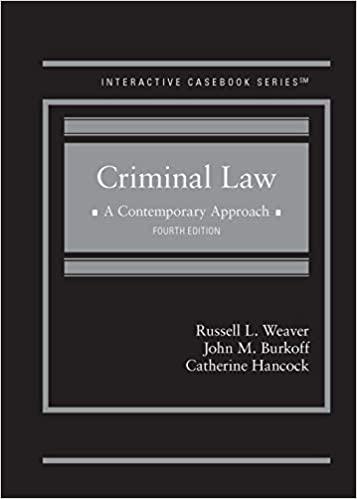Question
Read case Study I need Summary Case Citation: Mapp v. Ohio , 367 U.S. 643 (1961) Parties: Dollree Mapp (Petitioner) State of Ohio (Respondent) Facts
Read case Study
I need Summary
Case Citation: Mapp v. Ohio, 367 U.S. 643 (1961)
Parties: Dollree Mapp (Petitioner)
State of Ohio (Respondent)
Facts
On May 23, 1957, the Cleveland police department receive a notice that an individual who was wanted for questioning regarding a recent bombing that took place. They were told that in Mapp's residence, he would be hiding there as well as a large amount of police paraphernalia. When the police arrived at the house, they demanded the petitioner to open the door and let them in. Mapp refused after calling her attorney, who advised her to turn them down and ask them to come back with a search warrant. The police went ahead and informed headquarters of the incident and decided to take surveillance of the resident until backup came in.
Once five or more officers (in addition to the original squad) arrived at the premises, they went back into the residence. After Mapp did not arrive immediately to answer the door, at least one point of entrance was forced in order to get entrance into the residence and conduct their search. While this commotion was taking place, the petitioner's attorney had made it to the scene but he was denied entrance or the chance to speak to his client. By now Mapp had come in contact with one of the officers where she requested to see the warrant. A paper that was identified as such by the officer was briefly swung across her face to which point she took it away from the officer and shoved it down her blouse. The officer taking her "belligerent" behavior, Mapp was turned around and handcuffed which she then complied with since the force taken "hurted her". She was then led upstairs where her bedroom was being searched. The search spread across both floors and even traveled down to the basement. In this location (basement) a trunk was found and after opening, they gathered what seemed to be obscene material which under the Ohio statute, ownership of pornigraphy is a violation thus leading to her conviction.
Procedural History
Mapp was arrested in the fall of 1958, she was then tried, convicted, and sentenced to serving between 1-7 years in penitentiary. Alexander L. Keans (her attorney) appealed to the Ohio Supreme Court that her client had the right of privacy which was violated when the officers entered her residence without a warrant and the evidence seized during the search should be inadmissible since it was obtained through an illegal search. The Ohio Supreme Court went ahead and affirmed the conviction which led to Keans appealing the case to the U.S. Supreme Court.
Issues
- Did the sentencing court violate the petitioner's right to privacy when they allow the evidence seized without a warrant be admissible in the case?
- When the case was appealed to the Ohio Supreme Court, by affirming the conviction, did they violate the defendant's constitutional rights (4th amendment)?
Holding
Yes. The Fourth Amendment provides that the right of the people to be secure in their person, houses, papers, and effects, against unreasonable searches and seizures, shall not be violated, and no warrants shall be issued upon probable cause.
Yes, evidence seized without a search warrant cannot be used in state criminal prosecution under the 4th amendment and the 14th amendment, which extends that protection to state jurisdiction.
Decision
The majority decision of 6-3 that any evidence obtained in a search that was conducted by violating the fourth amendment cannot be admissible in state court. In this case, the Supreme Court concluded that there should be no reason why states should not be held to the same standard as the federal government.
Majority Opinion
The majority opinion was written by Justice Tom C. Clark. The six justices in the opinion declared that the evidence obtained within the violation of the 4th Amendment could not be admissible in the state court. The majority opinion relied on the legal doctrine known as "selective incorporation" which derived from the 14th Amendment due process clause, which bans states from creating laws that could infringe on the rights of American citizens. Using this legal doctrine, the Court was able to determine that state courts were subject to the "exclusionary rule."
Dissenting Opinion
Justice John M. Harlan disagreed with the majority when they decided to dismiss Mapp's First Amendment arguments. He proposed that since Mapp was convicted under an Ohio statute which criminalizes the possession of pornography, the problem was whether the law "consistent with the rights of free throught and expression assured by state action by the 14th Amendment."
He proceeds to argue that by applying the exclusionary rule to the states, this violates the principles of stare decisis and judicial restraint.
Case Significance
The decision overturned Wolf v. California,a 1949 case which held that the 4th Amendment could not forbid the use of illegally obtained evidence when it came to state courts. This reinforced the idea that under the 4th and 14th Constitutional Amendments, any illegally seized evidence could not be used in a state criminal trial.
Conclusion
The Supreme Court ruled that Mapp's constitutional rights were violated when evidence was admitted by committing an illegal search and seizure of her property. The Court introduced the exclusionary rule when it came to state courts under the 14th Amendment.
Step by Step Solution
There are 3 Steps involved in it
Step: 1

Get Instant Access to Expert-Tailored Solutions
See step-by-step solutions with expert insights and AI powered tools for academic success
Step: 2

Step: 3

Ace Your Homework with AI
Get the answers you need in no time with our AI-driven, step-by-step assistance
Get Started


